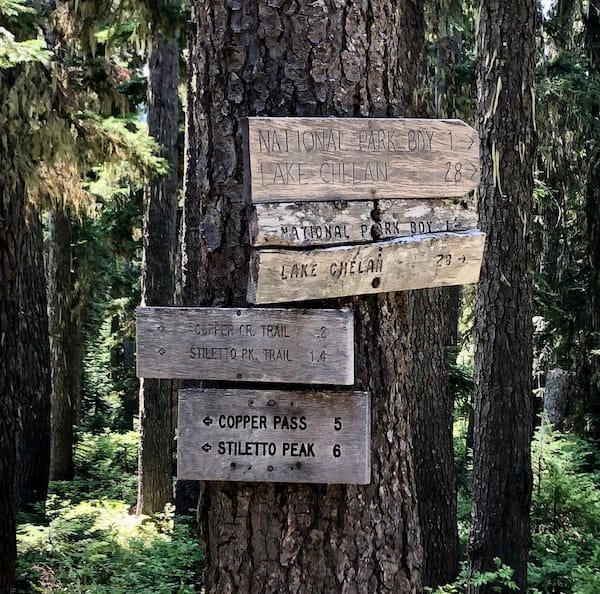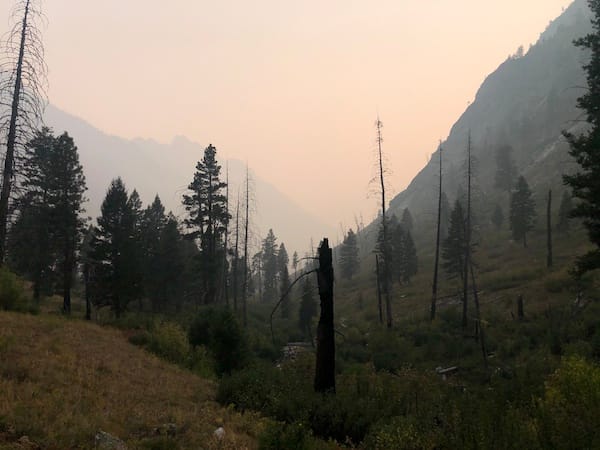Repeat after me: I will prepare a backup plan for my next backpacking trip… and once more for the people in the back, I will prepare a backup plan for my next backpacking trip.

But, seriously have an alternate expedition planned and ready to go. I’ve changed destinations the day before, day of, and even enroute. There are many complications that may waylay your best laid plans; weather, road closures, trail closures, snowpack, uncrossable waterways, fires, or in 2020 massive smoke clouds covering the entire western US. The far-reaching, wildfire induced haze set in motion my bail out of the Sawtooths on day three of the planned seven. Extreme summer lightning storms have made me detour from the Wallowas to the Sisters Wilderness. Too much snow in the hills has had me rethink an Olympics National Park trip and head to the “southern” climes of the Rogue River. A road closure near Mount St. Helens instigated a turn around at the closed gate and we hightailed it to the Goat Rocks.
The one variable in common? I was prepared with an alternate route each time.
So what does a back up plan look like?
- Pre-trip planning: This is the absolutely critical first step. While print and online guide books are an excellent resource, a trip write up could be out of date even a year or less after publication. The wilderness is dynamic. Rivers reroute, trails get overgrown, fires close areas, road can be blocked, and on and on. Check recent trip reports; and contact the Forest Service, BLM, State Park, and local hiking clubs for information. Ask where the water sources are, find out if streams are fordable, inquire if trail maintenance has been done, or if they know if anyone has been through the area recently.
- Bring the appropriate maps: I mean who doesn’t want more maps in their library? It’s the most important piece of gear you can bring for your backup plan. Also make sure the maps for your original itinerary cover escape routes in case you need to bail out.
- Actual gear: Are you going to need an extra day of food? Bring it. Are you going to need extra or different clothing or gear? Pack ’em just in case. Snow on the trail? Bring those spikes or crampons. What you don’t need can be left in the car, but if you didn’t bring them, you can’t pack them.
- Where you’re at makes a difference as well: If you’re still in town you have the most options for planning and gearing up for your substitute trip. But, if you are on the road you need to have the extras with you. You can’t count on getting the supplies you need in the small towns often nearest your destination.
2:00 PM 3:30 PM 5:30 PM
If you are on trail it’s a different situation. This is where maps extending out of your original route are imperative. You’ll want to know how to efficiently exit or reroute a trip. Whether due to injury, inclement weather, unforeseen trail issues such as closures/impassability, or in 2020 the smoke as previously mentioned.
A change of route on trail may add miles or days (hopefully only one day though). For this reason I pack heavy on snacks. So, while I don’t bring an extra “meal” I carry enough extra food (and coffee) for at least a day. Likewise, in case of emergency I always pack my ID, phone, a credit card, health insurance card, and cash in small bills in case my exit point is not going to be near my vehicle. These carry an insignificant weight penalty and are universally handy.
Lastly, carry your ten essentials, extra food, rain jacket, and extra layers even on day hikes. Most Emergency situations happen to underprepared hikers on these shorter jaunts. The extra weight can save your life, plus a heavier daypack makes for good training. AIT or Always In Training as my wife and I jokingly say to each other.
In the end it’s more likely that your trip will be abbreviated, but a short, fun trip is better than a longer miserable one.
If you enjoyed this article please comment, share on social media, or tell a friend!
And if you’d like to know more about me, check out my About and Random Stuff I Dig pages.





